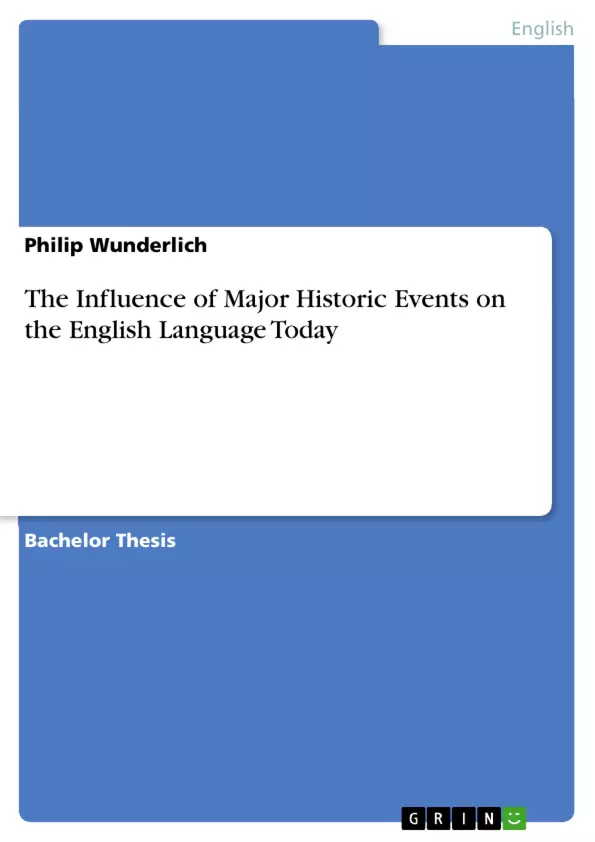This Bachelor Thesis will be analyzing the English language by investigating selected historical events which influenced the English language system and are therefore reasons for the contemporary state of Modern English (ModE).
The following question for this paper arises: "What major historic events influenced the English language and what impact did they have in a degree that is still visible in Modern English?" At first, a terminology section will be provided to explain the terms which will be used.
After that, by using diachronic facts, synchronic ModE characteristics in terms of lexicon and orthography will be analyzed. Subsequently, historical explanations will be given to underline the features and irregularities of ModE. This data will then be used to answer the question of this Bachelor Thesis.
Approximately 400 million people around the world learn English as their first language. Further studies have shown that around 1500 million people are able to speak English to some degree. This does not take into account the tremendous amount of people who learn English as their second language.
English itself was brought to England when Celtic was the main language before the German-speaking Anglo-Saxons came and influenced the existing language. It was then influenced by numerous other languages such as French which found its way into England after the Norman Conquest in 1066.
According to Ferdinand de Saussure, linguists agree that living languages which are actively used are constantly changing throughout time. English is very interesting as it was so strongly affected even though only around 1500 years have passed since English came into existence. I became exceptionally interested in where the Modern English (ModE) irregularities and features originated from and how English developed into its contemporary form.
Inhaltsverzeichnis (Table of Contents)
- 1. Introduction
- 2. Terminology
- 3. Modern English characteristics
- 3.1 Lexicon
- 3.1.1 Suffixes: Stress shifting
- 3.1.2 Allomorphy
- 3.1.3 Bound roots
- 3.2 Orthography
- 3.2.1 Phonological changes: Long Vowels and Diphthongs
- 3.2.2 Silent Graphemes
- 3.2.3 Digraphs
- 3.1 Lexicon
- 4. Historical explanations
- 4.1 Norman Conquest
- 4.1.1 New diphthongs
- 4.1.2 The fricative voice contrast
- 4.2 Great Vowel Shift
- 4.3 Loss of sounds
- 4.1 Norman Conquest
- 5. Conclusion
Zielsetzung und Themenschwerpunkte (Objectives and Key Themes)
This Bachelor Thesis aims to analyze the English language by investigating selected historical events that influenced the English language system and are therefore reasons for the contemporary state of Modern English (ModE). The central question explored in this paper is: "What major historic events influenced the English language and what impact did they have in a degree that is still visible in Modern English?”
- Diachronic analysis of Modern English features
- Impact of historical events on the English language system
- Analysis of Modern English lexicon and orthography
- Examination of historical explanations for ModE irregularities
- Tracing the influence of language contact on ModE
Zusammenfassung der Kapitel (Chapter Summaries)
The first chapter introduces the topic of inconsistencies in Modern English and provides background information on the development of the language. It discusses the significance of studying historical events that have shaped English.
Chapter two defines key terminology used throughout the thesis, including orthography, phonology, phoneme, grapheme, digraph, affix, stress, borrowing, and lexeme. These definitions establish a foundation for understanding the concepts presented in subsequent chapters.
Chapter three focuses on Modern English characteristics in terms of lexicon and orthography. It examines specific examples of language features such as suffixes, allomorphy, bound roots, phonological changes, silent graphemes, and digraphs, providing insights into the synchronic irregularities of ModE.
Chapter four delves into historical explanations for the features and irregularities observed in Modern English. It analyzes the impact of significant historical events such as the Norman Conquest and the Great Vowel Shift on the development of the language.
Schlüsselwörter (Keywords)
The key concepts explored in this Bachelor Thesis include Modern English, diachronic analysis, synchronic features, lexicon, orthography, phonological changes, historical explanations, Norman Conquest, Great Vowel Shift, language contact, and language change.
- Arbeit zitieren
- Philip Wunderlich (Autor:in), 2016, The Influence of Major Historic Events on the English Language Today, München, GRIN Verlag, https://www.grin.com/document/497089



